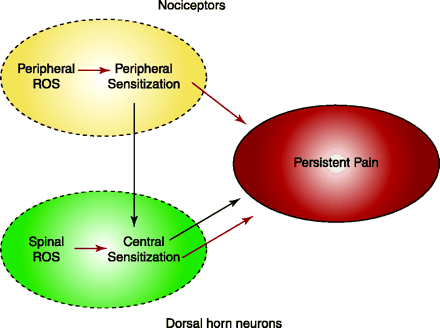
- Institution: Stanford Univ Med Ctr Lane Med Lib/Periodical Dept/Rm L109
- Sign In as Member / Individual
The Role of Reactive Oxygen Species (ROS) in Persistent Pain

Hypothetical reactive oxygen species (ROS) involvement in the production of persistent pain. In peripheral tissue, ROS are produced in many pathophysiological conditions, including inflammation. ROS will sensitize nociceptors so that they not only respond more vigorously to noxious stimuli but also start to respond to normally subthreshold stimuli. This peripheral sensitization not only induces pain directly (red arrows), but also induces central sensitization in the spinal cord, which indirectly (black arrows) contributes to pain as well. In the spinal cord, ROS are produced in many pathophysiological conditions, such as having persistent abnormal afferent inputs. ROS produced in the spinal cord can lead to central sensitization (red arrows), which in turn produces pain. Thus, central sensitization can lead to pain with or without peripheral sensitization.


